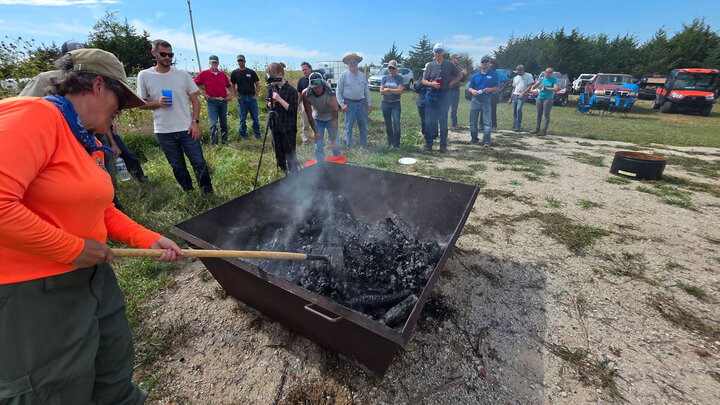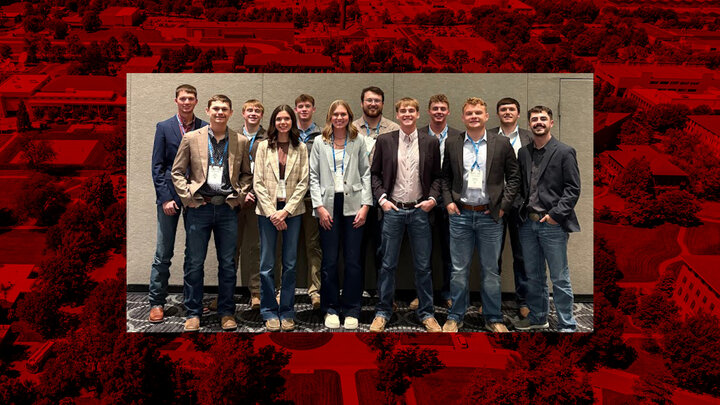Andrea Basche's research involves the successful incorporation of cover crops into Nebraska cropping systems. Greg Nathan | University Communication
Three University of Nebraska–Lincoln Department of Agronomy and Horticulture faculty were awarded a grant from the Nebraska Environmental Trust to develop a decision-support tool for the successful incorporation of cover crops into Nebraska cropping systems.
Principal investigators include Andrea Basche, assistant professor, Daren Redfearn, associate professor, and Katja Koehler-Cole, research assistant professor.
Soil degradation remains a major challenge globally that threatens long-term agricultural productivity. Over the last several years, some watersheds in Nebraska have experienced substantial soil erosion losses that will require many decades to replace at current soil formation rates.
Corn and soybean are the predominant annual crops grown in Nebraska. Conservation measures on these acres are imperative for ensuring healthy soils and water quality sustainability with a more variable climate.
Cover crops – growing a plant to protect the soil when it would otherwise be bare – represent a significant opportunity to reduce soil degradation, and if managed to optimize benefits, could promote soil regeneration on nearly three-quarters of Nebraska cropland. Cover crops have been shown to increase water retention, reduce soil erosion and offset carbon declines with increasing climate variability. They may also be used as supplemental forage in fall and spring when livestock feed is limited.
According to the USDA’s most recent Census of Agriculture less than 4% of the 19-million cropland acres in the state are utilizing the practice despite cover crop benefits. Farmers report that their largest challenge is the limited planting window for fall seeded cover crops as well as the timing needed for spring termination. Farmers also report a need for more regionally-based recommendations on a range of cover crop species for corn-soybean rotations, as well as a desire to learn more about cover crop management from their producer peers.
More than half of Nebraska producers surveyed cited forage production for livestock feed as a reason for growing cover crops, representing an opportunity to increase cover crop use in the state. Another opportunity to reducing cover crop barriers is utilizing cash crop varieties that can be harvested earlier, allowing for more time to plant cover crops in the fall.
The overall goal of this project is to establish a network of farmers and scientists engaged in managing and studying cover crops. This network will compile previously collected data and will integrate existing performance and management information to better understand cover crop performance across different regions, management scenarios (i.e. planting dates, cover crop species), climatic zones and soil types. The farmers and scientists will provide regular feedback to the research team to answer region-specific questions of importance to producers.
The data will serve as the foundation for a newly created statewide decision-support web tool which will be developed through the Nebraska’s Holland Computing Center.
The producer network will ensure that the tool addresses the most pertinent producer needs and will be designed to support a range of locations, climates and soil types across the state in evaluating tradeoffs associated with crop yields and cover crop biomass. The tool will also quantify potential forage production and forage quality, as well as environmental improvements associated with reduced erosion, decreased nitrate loss, increased carbon and enhanced water storage. This project will benefit crop and livestock producers across the state and ultimately lead to greater environmental outcomes for the general public of Nebraska.
Tools such as this that answer common producer questions, and ultimately help reduce cover crop barriers, have the potential to increase cover crop acreage, offering soil regeneration and environmental benefit for the broader public.
The Nebraska Environmental Trust Board announced funding for this project at its meeting in Lincoln on April 4. The first year award is $34,900 with a potential for second- and third-year funding totaling $41,530 and $41,180 respectively. The project is one of the 117 projects receiving $19,501,444 in grant awards from the Nebraska Environmental Trust in 2019. Of these, 85 were new applications and 32 are carry-over projects.
The Nebraska Legislature created the Nebraska Environmental Trust in 1992. Using revenue from the Nebraska Lottery, the Trust has provided over $305 million in grants to over 2,200 projects across the state. Anyone – citizens, organizations, communities, farmers and businesses – can apply for funding to protect habitat, improve water quality and establish recycling programs in Nebraska. The Nebraska Environmental Trust works to preserve, protect and restore our natural resources for future generations.




